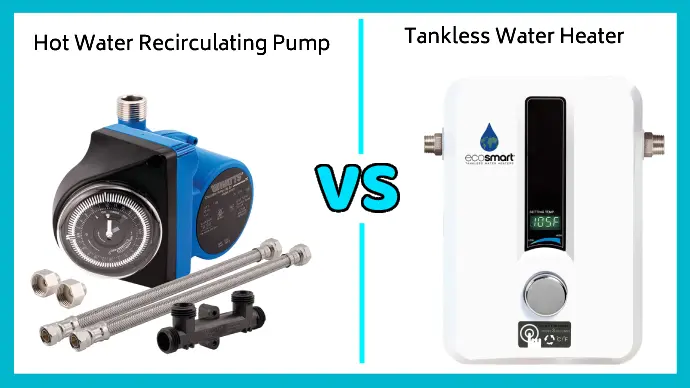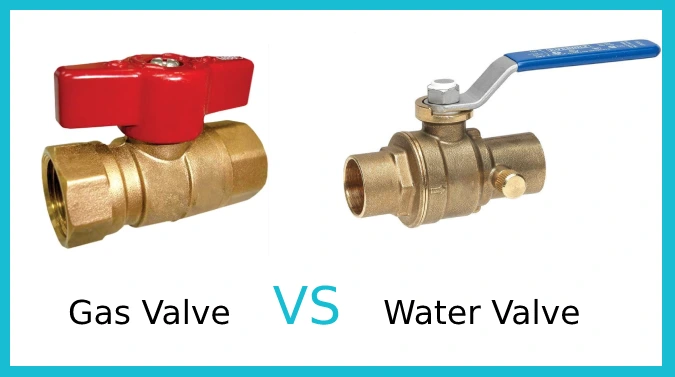Last Updated on June 7, 2023
Are you tired of waiting for hot water to reach your shower or sink? You may consider installing a hot water recirculating pump or a tankless water heater. Both options can provide hot water on demand, but they operate in different ways and have unique advantages and disadvantages.
Hot water recirculating pump is a device that keeps hot water circulating through your plumbing system, allowing for instant hot water at any faucet. Conversely, a tankless water heater heats water only when you need it, eliminating the need for a storage tank and providing a constant hot water supply.
Although both options can help you save energy and money, choosing the right one depends on your specific needs and budget. Today, we will explore the differences between a recirculating hot water pump and a tankless water heater and help you make an informed decision for your home.
Differences Between Hot Water Recirculating Pump vs Tankless Water Heater

Understanding the difference between a hot water recirculating pump and a tankless water heater is important before you upgrade your home’s hot water system. Here are some key differences.
Working Function:
Hot water recirculating pump operates by circulating hot water through plumbing, ensuring hot water is quickly available at fixtures. The pump is activated by a thermostat or a timer, which turns it on when the water temperature drops below a certain level.
The pump then circulates the water back to the water heater, where it’s reheated and recirculated. This process repeats itself until hot water is available at the fixture.
A tankless water heater heats water on demand as it passes through the unit, eliminating the storage tank. When a hot water faucet is turned on, cold water flows through the unit and is heated by a burner or an electric element.
The heated water then flows out of the unit and to the fixture. This process continues until the faucet is turned off, at which point the unit shuts off until the next time hot water is needed.
Water Conservation:
The hot water recirculating pump is designed to reduce water wastage by providing instant hot water at the fixtures. It eliminates the need to let the water run until it reaches the desired temperature.
This means that you can enjoy hot water immediately without wasting any water. This system is perfect for households that use hot water and want to reduce their water bills.
Alternatively, tankless water heaters are more water-efficient than traditional tank-based systems. Because no standby water needs to be constantly reheated. This means you can save water by not waiting for the water to heat up.
Energy Efficiency:
While both systems have their benefits, the tankless water heater is generally considered more energy-efficient. This is because tankless heaters only heat water when needed, avoiding the energy losses associated with standby heat in traditional tank heaters.
Meanwhile, the continuous operation of the hot water recirculating pump can consume energy, although newer models have energy-saving features and timers to optimize usage. But even with these features, the pump still uses more energy than a tankless water heater.
Installation and Cost:
Installing either a recirculating hot water pump or a tankless water heater can be costly and complex. Professional installation and modifications to plumbing and electrical/gas systems are required.
A hot water recirculating pump may be more complicated to install as it could necessitate additional plumbing and a dedicated return line. It requires modifications to the existing plumbing system.
Depending on installation requirements, a hot water recirculating pump costs between a few hundred to several thousand dollars.
Alternatively, a tankless water heater requires proper sizing and gas/electric connections. Upgrading the existing gas lines or electrical systems may be necessary, further increasing the installation cost.
Maintenance:
Like any other appliance, both systems require regular maintenance to ensure optimal performance and longevity. Maintenance primarily involves checking and maintaining the pump’s functionality for hot water recirculating pumps. This includes regular cleaning, lubrication, and checking for leaks.
On the other hand, tankless water heaters require descaling the heat exchanger and cleaning the filters to prevent mineral buildup and ensure efficient operation. Neglecting maintenance can lead to decreased efficiency and even system failure, so schedule regular maintenance for both systems.
Flexibility:
While both systems offer some level of versatility, there are key differences to remember. Hot water recirculating pumps can be retrofitted to an existing plumbing system, offering more flexibility in installation options.
Meanwhile, tankless water heaters can be installed in various locations, such as under sinks, inside cabinets, or mounted on walls, providing more space-saving opportunities. Also, some tankless water heaters can even be installed outdoors, making them a great option for homes with limited indoor space.
Where should a hot water recirculating pump be installed?

To ensure efficient and effective operation, the ideal location for installing a hot water recirculating pump is before the first hot water lateral. This means that the pump should be installed in the hot water line that comes from the top of the water heater and goes into the house.
Installing the pump before the initially hot water lateral ensures that hot water is available immediately when a tap is turned on. This means there’s no need to wait for warm water to travel through the pipes from the water heater to the tap.
How much does it cost to have a hot water recirculating pump installed?
Getting a recirculation line installed in your home can be a considerable expense, ranging from $4,200 to $6,900, with installation costs being a significant part of the overall cost.
While the pump itself may not be too expensive, the installation process can be challenging, especially if you’re unfamiliar with plumbing. It’s important to note that the installation cost can vary depending on the complexity of your home’s layout and the type of pump you choose.
What is the life expectancy of a hot water recirculating pump?
Industry experts say a properly installed and maintained recirculating pump can last several years. A good quality and well-maintained pump can last 5-10 years, making it a great investment for any homeowner.
If you’re considering having a hot water recirculating pump, here are some factors that can affect its lifespan:
- Quality of the pump: Investing in a high-quality pump can extend its lifespan significantly.
- Maintenance: Regular maintenance, such as cleaning or replacing filters, can help keep your pump running smoothly for longer.
- Usage: The more often you use your pump, the more wear and tear it will experience, impacting its lifespan.
- Water quality: Hard water can lead to mineral buildup in your pump, which can cause damage over time.
Is a recirculating hot water pump worth it?

You’re probably thinking, “Is investing in a device that saves water and money worth it?” The answer is yes; investing in a hot water circulator pump is worth it.
Not only does it save water, as much as 1000 gallons per person annually, but it also saves you money on your utility bill. Plus, it’s environmentally conscious to conserve water.
Also, hot water circulator pumps have a long lifespan, so it’s a worthy investment for your home. In addition to saving water and money, it provides convenience as you don’t have to wait for hot water for your faucet or shower.
Can you run out of hot water on a tankless water heater?
Tankless water heaters are great but may struggle to meet demand if too many things use hot water simultaneously. Here are three reasons why this could happen:
- Size of the unit matters: Tankless water heaters come in different sizes. The bigger the unit, the more hot water it can produce. If you have a large household with many people and appliances that require hot water, you may need to invest in a larger unit to avoid running out of hot water.
- Temperature of the incoming water matters: Tankless water heaters heat the water as it flows through the unit. If the incoming water is too cold, the unit will have to work harder to heat it, which can reduce the amount of hot water it can produce.
- Flow rate of the water matters: Tankless water heaters have a specified flow rate: the amount of hot water they can produce at a given time. If too many appliances use hot water at once, the flow rate may exceed the unit’s capacity, causing it to struggle to keep up with demand.
What is the average cost of putting in a tankless water heater?
Tankless units typically cost $1,200 to $3,500 to install, which is an important factor to consider. This cost can vary based on factors such as the size and complexity of the installation, as well as the location and accessibility.
When budgeting for a tankless water heater installation, consider any additional costs that may arise. You should also hire a professional installer with experience with tankless units since improper installation can damage your house.
What is the disadvantage of a tankless water heater?

Although tankless water heaters have significant energy savings over time, their higher initial cost may be a drawback for some homeowners. Tankless water heaters can cost up to three times as much as traditional storage-tank models. This can be a big upfront expense for homeowners already strapped for cash.
Also, installing a tankless water heater can be more complicated and costly than installing a traditional model. This is because tankless heaters require special electrical and gas connections and may require additional retrofitting to existing plumbing systems.
Hot Water Recirculation Pumps or Tankless Water Heaters: Choose the Perfect Choices for Hot Water on Demand
If you’re looking for a cost-effective solution to have instant hot water throughout your home, a hot water recirculating pump might be the way to go. It’s easy to install and can save money on your energy bill. Plus, it’s great for the environment, reducing water waste.
But a tankless water heater might be the answer if you invest more upfront for a long-term solution. It’s efficient, can provide endless hot water, and has a longer life than standard water heaters. However, it does come with a higher price tag.
No matter which option you choose, remember that hot water recirculation pumps and tankless water heaters are both great options. So, make that investment, and enjoy hot water on your demand.



